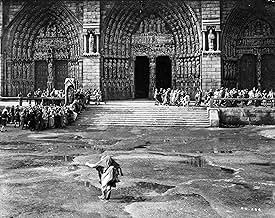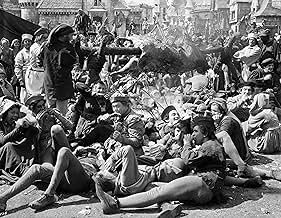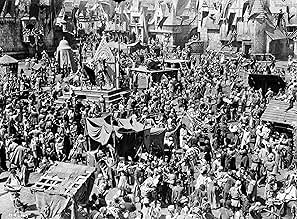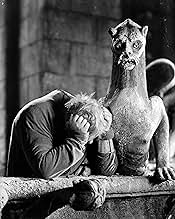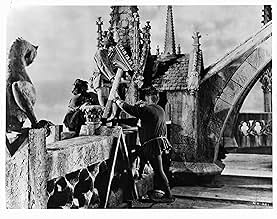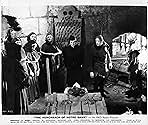IMDb RATING
7.8/10
13K
YOUR RATING
In 15th-century France, a gypsy girl is framed for murder by the infatuated Chief Justice, and only the deformed bellringer of Notre Dame Cathedral can save her.In 15th-century France, a gypsy girl is framed for murder by the infatuated Chief Justice, and only the deformed bellringer of Notre Dame Cathedral can save her.In 15th-century France, a gypsy girl is framed for murder by the infatuated Chief Justice, and only the deformed bellringer of Notre Dame Cathedral can save her.
- Director
- Writers
- Stars
- Nominated for 2 Oscars
- 1 win & 2 nominations total
Cedric Hardwicke
- Frollo
- (as Sir Cedric Hardwicke)
Helene Reynolds
- Fleur de Lys
- (as Helene Whitney)
Minna Gombell
- Queen of Beggars
- (as Mina Gombell)
Rod La Rocque
- Phillippe
- (as Rod LaRocque)
- Director
- Writers
- All cast & crew
- Production, box office & more at IMDbPro
Featured reviews
10llltdesq
The best of the many versions of The Hunchback of Notre Dame, for my money, is this one, although Lon Chaney's is a close second. Despite a Hollywood tendancy to change the novel's ending so as not to depress the cash customers (although, pray tell, if you're going to change the ending, why does no one ever see Quasimodo sailing off to Tahiti with the girl? Rule # 1: strong, handsome poets beat out disfigured cripples every time, even if they're heroes. This is more true in real life than in the movies. Take my word for this, I know from painful experience *sigh*)
Charles Laughton is exceptional and Maureen O'Hara would make any man swoon and is perfect for the part of Esmerelda. The support includes the usual suspects-Thomas Mitchell, Harry Davenport and many other familiar character actors. Strike up the band and start the parade. Thunderous applause. Most highly recommended.
Charles Laughton is exceptional and Maureen O'Hara would make any man swoon and is perfect for the part of Esmerelda. The support includes the usual suspects-Thomas Mitchell, Harry Davenport and many other familiar character actors. Strike up the band and start the parade. Thunderous applause. Most highly recommended.
A sweeping claim? Perhaps. But despite the presence in Hollywood over sixty subsequent years of Ford, Wyler, Kubrick, Coppola, Scorsese et al, The Hunchback of Notre Dame remains as fresh, as emotionally resonant and yes as powerfully artistic as the day it was made. What constitutes 'art' is of course a personal matter, just as the Breughel-like compositions of Hunchback might be as mystifying to someone whose favourite film is A Clockwork Orange (Lichtenstein?). But what makes Hunchback so satisfying as art is precisely that its makers didn't set out with art in mind. Dieterle and his co-creators embarked on the project with the aim of telling a great yarn, making it look authentic, and above all ENTERTAINING the audience. It is to this end that the Grand Guignol excesses of the novel were trimmed or altered, and the Hollywood bittersweet ending imposed. Audiences filed out with their Kleenex in hand having witnessed a three-ring circus of a movie, then went home to read the war-soaked newspapers.
Virtually every frame of this movie could be taken in isolation, made into a poster and hung on a wall. Examples include Gringoire cradling the dying Clopin as a rivulet of lead trickles past in the background, the voyeuristic eye of Quasimodo peering through fence palings at the dancing Esmeralda - I could go on and on. And pervading it all is the magnificent score of Alfred Newman, surely his finest ever.
Rather than sing its obvious praises, the film can simply speak for itself. As narrative, as character, as cinema craft, it is totally successful throughout. The Hunchback of Notre Dame is my favourite film of all time, bar none. Ten out of ten
Virtually every frame of this movie could be taken in isolation, made into a poster and hung on a wall. Examples include Gringoire cradling the dying Clopin as a rivulet of lead trickles past in the background, the voyeuristic eye of Quasimodo peering through fence palings at the dancing Esmeralda - I could go on and on. And pervading it all is the magnificent score of Alfred Newman, surely his finest ever.
Rather than sing its obvious praises, the film can simply speak for itself. As narrative, as character, as cinema craft, it is totally successful throughout. The Hunchback of Notre Dame is my favourite film of all time, bar none. Ten out of ten
Though the French have done many versions of Victor Hugo's celebrated classic, this version starring Charles Laughton has certainly stood the test of time and is the best known and loved in the English speaking world.
Lon Chaney, Sr. did an acclaimed silent version of The Hunchback of Notre Dame and Laughton was following a great tradition. And he did it in the manner of Chaney, almost without dialog. Not that Hugo wrote too much dialog for Quasimodo in his story, but except for his time with Esmerelda in the tower after he rescues her, Laughton is almost speechless in the film. Of course his character in addition to being deformed is also deaf from the ringing of those cathedral bells.
Quasimodo born deformed as he was, was left as an orphan on the steps of the Notre Dame cathedral in medieval Paris. Raised in the sheltered atmosphere of the church, he derives some joy in his duties as the bell ringer in the tower. His mentor is the brother of the archbishop played by Cedric Hardwicke and the archbishop is Walter Hampden. Quasimodo's life is useful, but without love.
But Laughton is crushing out on Esmerelda the gypsy girl played by Maureen O'Hara in her American screen debut. Problem is that Hardwicke is also getting hot and bothered by her.
Hardwicke's role is the second best acted in the film next to Laughton's. He's a man with shall we say some issues. He's purportedly committed to the church and it's celibacy requirements. But Dr. Freud wasn't around back in the day of Louis XI to tell us about sex drives. Hardwicke's desires mean only one thing, Esmerelda has to have bewitched him. When he kills Alan Marshal who is also interested in Maureen and looks like he's about to round third so to speak, the blame goes on Maureen.
What I like about the story is how the lives of two very ordinary people, Quasimodo and Esmerelda, become the focal point for a whole lot of religious and political issues of the day. The church, the peasants, the just developing middle class, and the nobility all have an agenda as far as the Esmerelda murder case is going. The only agenda poor Quasimodo has is he's in love with her.
Maureen O'Hara who was a discovery of Charles Laughton back in the United Kingdom was pushed by Laughton for the role of Esmerelda and traveled with him to America to play the part. She was grateful to him ever afterwards for any career she had and can't praise him enough for getting RKO to sign her.
Harry Davenport probably plays the most benign Louis XI ever put on film. It sure is a far cry from Basil Rathbone in If I Were King or Robert Morley in Quentin Durward. He plays him like the kindly grandfather he usually plays on screen.
Thomas Mitchell as Clopin the king of beggars and Edmond O'Brien as Gringoire the poet are two other significant roles. O'Brien gets his first substantial role on screen in The Hunchback of Notre Dame and this was a banner year for Thomas Mitchell. In 1939 he was also in Mr. Smith Goes to Washington, Gone With the Wind and Stagecoach for which he won Best Supporting Actor. He could have though for any one of these films.
When all is said and done though the film belongs to Charles Laughton who was the screen's best portrayer of tortured humanity. Even beneath all of Bud Westmore's grotesque make-up we can feel his anguish. He's not a stupid man Quasimodo, he knows how repulsive he is to most of the human race. He's childlike though, something like Peter Sellers in Being There, another character raised in a secluded atmosphere.
To see Charles Laughton at the top of his game in my humble opinion one has to see The Hunchback of Notre Dame.
Lon Chaney, Sr. did an acclaimed silent version of The Hunchback of Notre Dame and Laughton was following a great tradition. And he did it in the manner of Chaney, almost without dialog. Not that Hugo wrote too much dialog for Quasimodo in his story, but except for his time with Esmerelda in the tower after he rescues her, Laughton is almost speechless in the film. Of course his character in addition to being deformed is also deaf from the ringing of those cathedral bells.
Quasimodo born deformed as he was, was left as an orphan on the steps of the Notre Dame cathedral in medieval Paris. Raised in the sheltered atmosphere of the church, he derives some joy in his duties as the bell ringer in the tower. His mentor is the brother of the archbishop played by Cedric Hardwicke and the archbishop is Walter Hampden. Quasimodo's life is useful, but without love.
But Laughton is crushing out on Esmerelda the gypsy girl played by Maureen O'Hara in her American screen debut. Problem is that Hardwicke is also getting hot and bothered by her.
Hardwicke's role is the second best acted in the film next to Laughton's. He's a man with shall we say some issues. He's purportedly committed to the church and it's celibacy requirements. But Dr. Freud wasn't around back in the day of Louis XI to tell us about sex drives. Hardwicke's desires mean only one thing, Esmerelda has to have bewitched him. When he kills Alan Marshal who is also interested in Maureen and looks like he's about to round third so to speak, the blame goes on Maureen.
What I like about the story is how the lives of two very ordinary people, Quasimodo and Esmerelda, become the focal point for a whole lot of religious and political issues of the day. The church, the peasants, the just developing middle class, and the nobility all have an agenda as far as the Esmerelda murder case is going. The only agenda poor Quasimodo has is he's in love with her.
Maureen O'Hara who was a discovery of Charles Laughton back in the United Kingdom was pushed by Laughton for the role of Esmerelda and traveled with him to America to play the part. She was grateful to him ever afterwards for any career she had and can't praise him enough for getting RKO to sign her.
Harry Davenport probably plays the most benign Louis XI ever put on film. It sure is a far cry from Basil Rathbone in If I Were King or Robert Morley in Quentin Durward. He plays him like the kindly grandfather he usually plays on screen.
Thomas Mitchell as Clopin the king of beggars and Edmond O'Brien as Gringoire the poet are two other significant roles. O'Brien gets his first substantial role on screen in The Hunchback of Notre Dame and this was a banner year for Thomas Mitchell. In 1939 he was also in Mr. Smith Goes to Washington, Gone With the Wind and Stagecoach for which he won Best Supporting Actor. He could have though for any one of these films.
When all is said and done though the film belongs to Charles Laughton who was the screen's best portrayer of tortured humanity. Even beneath all of Bud Westmore's grotesque make-up we can feel his anguish. He's not a stupid man Quasimodo, he knows how repulsive he is to most of the human race. He's childlike though, something like Peter Sellers in Being There, another character raised in a secluded atmosphere.
To see Charles Laughton at the top of his game in my humble opinion one has to see The Hunchback of Notre Dame.
The 1939 version of Hugo's classic tale of beauty and the beast is definitely the definitive. It features a great performance by Charles Laughton as Quasimodo, dubbed the Hunchback of Notre Dame, because of his twisted appearance. It's pointless for me to talk about the story, because I'm sure everyone is familiar with it, it's one of the best works of literature ever produced. Id' just like to say this is a beautiful film about a beautiful person, cursed to be considered an out cast, "the king of fools"... Films like this and David Lynch's The Elephant Man really make you think a little differently about this so-called "beautiful" world. The Hunchback of Notre Dame has something for everyone to enjoy.
Considering that RKO was not renowned for epic film making, the production mounted for this version of Victor Hugo's classic story is surprisingly elaborate and effective.
The Paris set is a beautiful creation and possibly the greatest work by Van Nest Polglase, who with the producer Pan Berman is chiefly remembered today for the elegant art-deco designs for the Astaire-Rogers musicals.
The centrepiece of this remarkable set is the replica of Notre Dame cathedral which was only built to 50% height of the original; the towers above were added as an optical effect by use of a hanging miniature in some shots and by incorporating a glass painting in long shots. It's very convincing.
Dieterle was the perfect choice to direct this story. A student (and later collaborator) of Max Reinhardt, he marshals the huge crowd scenes (no CGi here - those thousands of peasants are all real people) with aplomb and his mastery of expressionistic imagery informs every frame.
Alfred Newman brought an intelligence to the musical score rare in Hollywood. His on screen credit "Musical adaptation and original composition by" reflects his skillful combining of original renaissance choral music by Tomas Luis de Victoria with his own work. He also uses a stirring Hallelujah chorus by uncredited Austrian Jewish émigré Ernst Toch (in Hollywood to escape the Nazis) for the memorable scene where Quasimodo rescues Esmeralda, reprised at the film's closing sequence as the camera pulls back from Notre Dame.
It's a great pity that a better restoration cannot be achieved for this beautiful film than is currently available on DVD. While the source print is serviceable, it is often poorly defined and suffers from many scratches. Perhaps it is the only print now extant? I would also love to see the original trailer rather than the re-release version.
While some may wish Basil Rathbone could have been released from contract at Universal to play Frollo, I think Cedric Hardwicke was ideal casting. As for Laughton, this may well be his signature role and a masterly example of great acting with hardly any dialogue at all.
As Mr Sinatra once said - "You can wait around and hope - but you won't see the likes of this again"
The Paris set is a beautiful creation and possibly the greatest work by Van Nest Polglase, who with the producer Pan Berman is chiefly remembered today for the elegant art-deco designs for the Astaire-Rogers musicals.
The centrepiece of this remarkable set is the replica of Notre Dame cathedral which was only built to 50% height of the original; the towers above were added as an optical effect by use of a hanging miniature in some shots and by incorporating a glass painting in long shots. It's very convincing.
Dieterle was the perfect choice to direct this story. A student (and later collaborator) of Max Reinhardt, he marshals the huge crowd scenes (no CGi here - those thousands of peasants are all real people) with aplomb and his mastery of expressionistic imagery informs every frame.
Alfred Newman brought an intelligence to the musical score rare in Hollywood. His on screen credit "Musical adaptation and original composition by" reflects his skillful combining of original renaissance choral music by Tomas Luis de Victoria with his own work. He also uses a stirring Hallelujah chorus by uncredited Austrian Jewish émigré Ernst Toch (in Hollywood to escape the Nazis) for the memorable scene where Quasimodo rescues Esmeralda, reprised at the film's closing sequence as the camera pulls back from Notre Dame.
It's a great pity that a better restoration cannot be achieved for this beautiful film than is currently available on DVD. While the source print is serviceable, it is often poorly defined and suffers from many scratches. Perhaps it is the only print now extant? I would also love to see the original trailer rather than the re-release version.
While some may wish Basil Rathbone could have been released from contract at Universal to play Frollo, I think Cedric Hardwicke was ideal casting. As for Laughton, this may well be his signature role and a masterly example of great acting with hardly any dialogue at all.
As Mr Sinatra once said - "You can wait around and hope - but you won't see the likes of this again"
Did you know
- TriviaFor the scene in which Quasimodo is whipped, Charles Laughton instructed an assistant director to twist his ankle outside of camera range so he would really be in pain. Even through the heavy hump and rubber body suit, he felt every lash and often came home badly bruised. Before the 16th take, director William Dieterle whispered to him, "Now, Charles, listen to me. Let's do it one more time, but this time I want you . . . I want you to suffer." According to Laughton's wife, Elsa Lanchester, the actor never forgave him for that.
- GoofsThe cathedral is shown as having a full flight of steps up to the front doors. Notre Dame has always been more or less level with the square (le Parvis).
- Quotes
[Last lines]
Quasimodo, the bell-ringer: [to one of the stone gargoyles] Why was I not made of stone - like thee?
- Crazy creditsPROLOGUE: "With the end of the 15th Century, the Middle Ages came to a close. Europe began to see great changes. France, ravaged by a hundred years of war, at last found peace. The people under Louis XI felt free to hope again --- to dream of progress. But superstition and prejudice often stood in the way, seeking to crush the adventurous spirit of man."
- Alternate versionsAlso available in a computer colorized version.
- ConnectionsEdited into The Clock (2010)
- SoundtracksAve Maria
(1572) (uncredited)
Music by Tomás Luis de Victoria
Sung by mixed chorus during opening credits
Details
- Release date
- Country of origin
- Official site
- Language
- Also known as
- El jorobado de Nuestra Señora de París
- Filming locations
- Production company
- See more company credits at IMDbPro
Box office
- Budget
- $1,800,000 (estimated)
- Runtime1 hour 56 minutes
- Color
- Aspect ratio
- 1.37 : 1
Contribute to this page
Suggest an edit or add missing content



